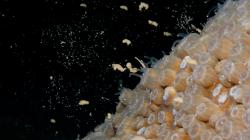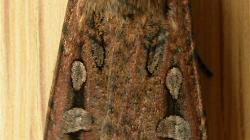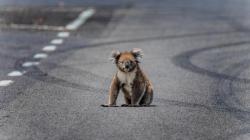'Breeding for balance' IS ONE OF OUR NEW TEACHING SEQUENCES FOR V9
- On the 'Sequence overview' tab you'll find all the lessons in this sequence and curriculum alignment.
- The 'Our design decisions' tab shows how key scientific ideas develop over the sequence, and shows how the sequence addresses curriculum achievement standards.
- Have you taught this sequence? Use the Feedback button to let us know how it went!
Launch
Lesson 1 • Cute enough to save
Students examine their understanding of breeding programs and investigate how the programs support the survival of endangered, vulnerable or at-risk species.
Inquire
Lesson 2 • Strategic survival
Students model the advantages and disadvantages of r- and K-reproductive strategies on populations.
Lesson 3 • Who killed the bogong moths?
Students examine the life cycle of the bogong moth and use argumentation to identify the possible causes of the population crash in 2017-2020. They connect the change in population to the vulnerabilities of r-strategy reproduction.
Lesson 4 • Antechinus Mother s Day
Students examine data that explores the advantages and disadvantages of the reproductive strategies of Antechinus agilis. This includes examining the advantages and disadvantages of females having 6 teats or 10 teats.
Act
Lesson 5 • Who will you save?
Students consolidate their learning by applying their understanding of reproduction strategies to the criteria developed to identify endangered species, and develop arguments to include a plant or animal in the Threatened Species Action Plan 2022-2032.
The Australian Academy of Science supports and encourages broad use of its material. Unless indicated below, copyright material available on this website is licensed under a Creative Commons Attribution-NonCommercial-ShareAlike 4.0 International (CC BY-NC-SA 4.0) licence.
Curriculum and syllabus alignment
Achievement standards
By the end of Year 9 students describe how the processes of sexual and asexual reproduction enable survival of the species. Students explain the role of publication and peer review in the development of scientific knowledge and explain the relationship between science, technologies and engineering. They analyse the different ways in which science and society are interconnected.
Students plan and conduct safe, reproducible investigations to test or identify relationships and models. They describe how they have addressed any ethical and intercultural considerations when generating or using primary and secondary data. They select and use equipment to generate and record replicable data with precision. They select and construct appropriate representations to organise, process and summarise data and information. They analyse and connect data and information to identify and explain patterns, trends, relationships and anomalies. They analyse the impact of assumptions and sources of error in methods and evaluate the validity of conclusions and claims. They construct logical arguments based on evidence to support conclusions and evaluate claims. They select and use content, language and text features effectively to achieve their purpose when communicating their ideas, findings and arguments to specific audiences.
Australian Curriculum V9 alignment
Science as a human endeavour
Science understanding
Describe the form and function of reproductive cells and organs in animals and plants, and analyse how the processes of sexual and asexual reproduction enable survival of the species
Science inquiry
Develop investigable questions, reasoned predictions and hypotheses to test relationships and develop explanatory models
Plan and conduct valid, reproducible investigations to answer questions and test hypotheses, including identifying and controlling for possible sources of error and, as appropriate, developing and following risk assessments, considering ethical issues, and addressing key considerations regarding heritage sites and artefacts on Country/Place
Select and use equipment to generate and record data with precision to obtain useful sample sizes and replicable data, using digital tools as appropriate
Select and construct appropriate representations, including tables, graphs, descriptive statistics, models and mathematical relationships, to organise and process data and information
Analyse and connect a variety of data and information to identify and explain patterns, trends, relationships and anomalies
Assess the validity and reproducibility of methods and evaluate the validity of conclusions and claims, including by identifying assumptions, conflicting evidence and areas of uncertainty
Construct arguments based on analysis of a variety of evidence to support conclusions or evaluate claims, and consider any ethical issues and cultural protocols associated with accessing, using or citing secondary data or information
Write and create texts to communicate ideas, findings and arguments effectively for identified purposes and audiences, including selection of appropriate content, language and text features, using digital tools as appropriate
Australian curriculum content links
| Science understanding core concept: A diverse range of living things have evolved on Earth over hundreds of millions of years; this process is ongoing. |
| Sub-strand | Content descriptor | AC code | Achievement standard | Elaboration/ application |
|---|---|---|---|---|
| SHE: Nature and development of science | Explain how scientific knowledge is validated and refined, including the role of publication and peer review. | AC9S9H01 | Students explain the role of publication and peer review in the development of scientific knowledge and explain the relationship between science, technologies and engineering. | Students review each other’s argumentation processes and compare this to the peer review process (Lesson 4). |
| SHE: Nature and development of science | Investigate how advances in technologies enable advances in science, and how science has contributed to developments in technologies and engineering. | AC9S9H02 | Students explain the role of publication and peer review in the development of scientific knowledge and explain the relationship between science, technologies and engineering. | Students explore how the development and use of radio transmitters have allowed scientists to gain a greater understanding of how animals interact with the environment around them (Lesson 4). |
| SHE: Use and influence of science | Analyse the key factors that contribute to science knowledge and practices being adopted more broadly by society. | AC9S9H03 | Students analyse the different ways in which science and society are interconnected. | Students explore factors that contribute to society deciding which plants or animals receive the most funding and the criteria used by international organisations to determine which plants and animals are endangered (Lessons 1 and 5). |
| SHE: Use and influence of science | Examine how the values and needs of society influence the focus of scientific research. | AC9S9H04 | Students analyse the different ways in which science and society are interconnected. | Students explore factors that contribute to society deciding which plants or animals receive the most funding and the criteria used by international organisations to determine which plants and animals are endangered (Lesson 1 and 5). |
| SU: Biological Sciences | Describe the form and function of reproductive cells and organs in animals and plants, and analyse how the processes of sexual and asexual reproduction enable the survival of the species. | AC9S9U02 | Students describe how the processes of sexual and asexual reproduction enable survival of the species. | Students explore the characteristic or r- and K-strategies of reproduction (Lessons 2-4) |
| SI: Questioning and predicting | Develop investigable questions, reasoned predictions, and hypotheses to test relationships and develop explanatory models. | AC9S9I01 | Students plan and conduct safe, reproducible investigations to test or identify relationships and models. | Students use modelling and secondary data to explore the reproductive strategies of different animals including the bogong moth and Antechinus marsupial mouse (Lessons 2-4). |
| SI: Planning and conducting | Plan and conduct valid, reproducible investigations to answer questions and test hypotheses, including identifying and controlling for possible sources of error and, as appropriate, developing and following risk assessments, considering ethical issues, and addressing key considerations regarding heritage sites and artefacts on Country/Place. | AC9S9I02 | Students describe how they have addressed any ethical and intercultural considerations when generating or using primary and secondary data. | Students use modelling and secondary data to explore the reproductive strategies of different animals, including the bogong moth and Antechinus marsupial mouse (Lessons 2-5). |
| SI: Planning and Conducting | Select and use equipment to generate and record data with precision to obtain useful sample sizes and replicable data, using digital tools as appropriate. | AC9S9I03 | Students select and use equipment to generate and record replicable data with precision. | Students use modelling to explore the reproductive strategies of different animals (Lesson 2). |
| SI: Processing, modelling and analysing | Select and construct appropriate representations, including tables, graphs, descriptive statistics, models, and mathematical relationships, to organise and process data and information. | AC9S9I04 | Students select and construct appropriate representations to organise, process and summarise data and information. | Students use secondary data to explore the reproductive strategies of different animals and communicate their findings (Lessons 2, 5). |
| SI: Processing, modelling and analysing | Analyse and connect a variety of data and information to identify and explain patterns, trends, relationships, and anomalies. | AC9S9I05 | Students analyse and connect data and information to identify and explain patterns, trends, relationships and anomalies. | Students use modelling and secondary data to explore the reproductive strategies of different animals, including the bogong moth and Antechinus marsupial mouse (Lessons 2-4). |
| SI: Evaluating | Assess the validity and reproducibility of methods and evaluate the validity of conclusions and claims, including by identifying assumptions, conflicting evidence, and areas of uncertainty. | AC9S9I06 | Students analyse the impact of assumptions and sources of error in methods and evaluate the validity of conclusions and claims. | Students use modelling and secondary data to explore the reproductive strategies of different animals, including the bogong moth and Antechinus marsupial mouse (Lessons 2-5). |
| SI: Evaluating | Construct arguments based on analysis of a variety of evidence to support conclusions or evaluate claims, and consider any ethical issues and cultural protocols associated with accessing, using, or citing secondary data or information. | AC9S9I07 | Students construct logical arguments based on evidence to support conclusions and evaluate claims. | Students use modelling and secondary data to explore the reproductive strategies of different animals, including the bogong moth and Antechinus marsupial mouse (Lessons 2-5). |
| SI: Communicating | Write and create texts to communicate ideas, findings, and arguments effectively for identified purposes and audiences, including selection of appropriate content, language, and text features, using digital tools as appropriate. | AC9S9I08 | Students select and use content, language and text features effectively to achieve their purpose when communicating their ideas, findings and arguments to specific audiences. | Students use criteria from the Red List (International Union for Conservation of Nature and Natural Resources) to argue that their selected animal should be included (Lesson 5). |
Teaching notes
- Read through the teaching sequence.
- Note any adaptations you would like to make to suit your school’s and students’ context.
- Check that your IT department will allow access to YouTube or other videos.
- Complete the ordering of laboratory equipment and rooms (if required).
- Some students may have an ethical objection to keeping animals in a zoo. It is useful to emphasis the variety of breeding programs that are a key element in most zoos in Australia.
Lab tech notes
As required in all states, teachers must prepare their risk assessments of the activities. Some of the risks that need to be considered are listed below.
Lesson 2
Counters provided should have different coloured sides (similar to a coin). Alternatively, provide a permanent marker so that sides can be marked heads or tails. These marks can be removed with a cotton ball with rubbing alcohol (isopropyl alcohol) if required.
Lesson 4
If the ‘physical modelling alternative’ activity is being used, each group will need an opaque paper bag containing 20-40 counters and a permanent marker. The marks on the counters can be removed with a cotton ball with rubbing alcohol (isopropyl alcohol) if required.
The materials required for each lesson are listed on the lesson's page.




